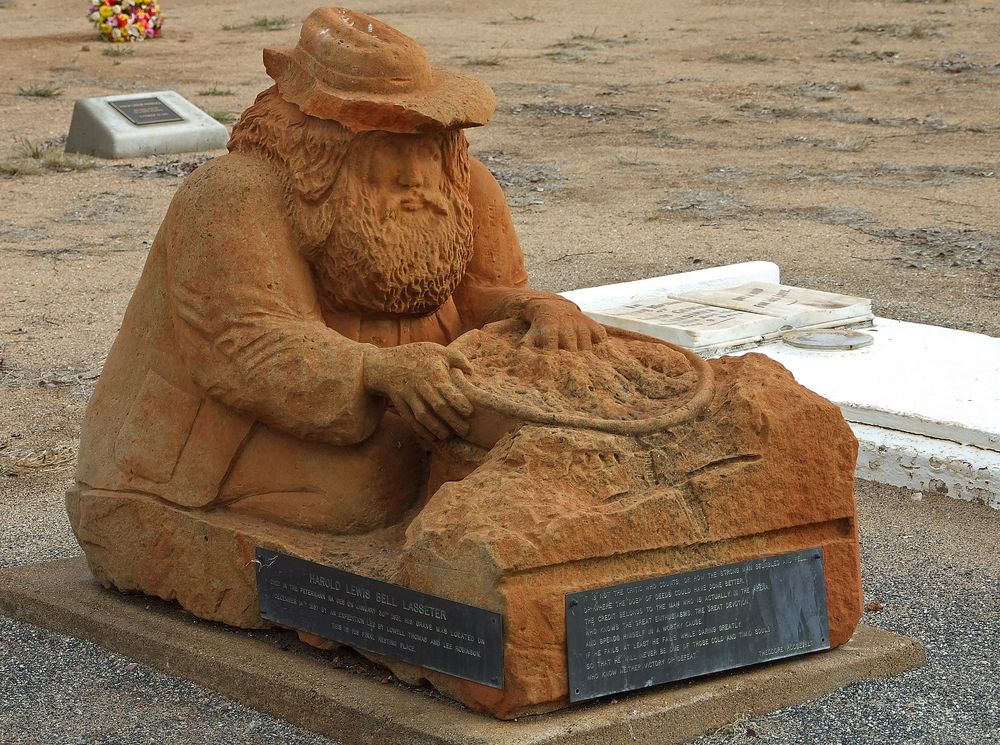In 1929, Australia got its own living and breathing Indiana Jones. It was Lewis Harold Bell Lasseter, a gold prospector who would become the face of the greatest outback mystery of all times. Harold claimed that some 30 years before he had discovered a gold bearing reef in central Australia. His hopes were to go back into the vast expanse and rediscover the lost treasure. Were the claims vague? Yes. Was there evidence? Not exactly. But did the news make waves among historians and gold prospectors? Without a doubt.

The vast Australian outback. Photo: Steven Penton/Flickr
Almost a century later, curious explorers continue to scour the land for a trace of the treasure, but to no avail. But the one who got this ball rolling was Lasseter himself. By 1930 he had collected sufficient funds, and began gathering a Central Australian Gold Exploration (CAGE) expedition to set out in search of the gold. Accompanying him was experienced bushmen Fred Blakeley; two other prospectors Frank Colson and George Sutherland; Phil Taylor, the driver of their transport; explorer Blakeston-Houston (the governor-general's aide); and Errol Coote, the pilot of a small aircraft which they took along with them. From the very beginning, Lasseter was a sullen companion and a vague guide. The group headed to Ilbilba, where an aerodrome was created earlier that year for another expedition. With great physical hardship, the group reached as far as Mount Marjorie, when Lesseter declared that they were going the wrong direction. Exasperated, Blakeley declared Lasseter a charlatan and left. Lasseter then took dingo-shooter, Paul Johns, and his team of camels, and set off towards Kata Tjuṯa. One afternoon Lasseter returned to camp and announced that he had relocated the gold reef but refused to reveal its location. Johns, who by now doubted Lasseter's sanity, accused him of being a liar. A fight ensued, and Johns left Lasseter to his own devices. Lasseter set out all alone, impervious to the hindrances that lay ahead of him, taking with him John’s two camels. That was the last anyone saw of him. A year later his remains were found in a remote desert cave. A diary by his cold side revealed that he had died of starvation after having lived among the Aborigines for several months. The gold remained undiscovered.

Lewis Harold Bell Lasseter
In Search of Gold
There was enough meat in the story for the media to juice out; Lasseter’s reef was by then a public curiosity. His journey was retold in 1931 as Lasseter's Last Ride by Ion Idriess. By 1970 people were deep-diving into the gold search. Years passed and in 2013 a documentary titled Lasseter’s Bones revealed newer dimensions of Lasseter’s tale, piquing interests in the fabled legend once again.
During the making of Lasseter’s Bones, filmmaker Luke Walker uncovered pieces of communication between Harold and a Swedish named Olof Johanson who also knew the location of the gold. Harold had invited Olof on the 1930 expedition, but the latter declined and went ahead with a different expedition group, and in doing so, probably escaped the fatal end that Harold met. But Olof could not recover the lost gold either.
According to Lasseter, the gold reef was discovered on the western edge of the MacDonnell Ranges. Many claimed to have found the gold, many claimed to know how to find it. Explorers continually traversed the vermillion peaks for years to come, feeding on the tiniest clues that Lasseter’s diary accounts revealed.

The sensational discovery afforded Harold a remarkable grave when his body was found. Photo: Catherine/Flickr
By the 2000’s, Google Earth and other similar tracking software made it possible to identify mineral rich locations as well as magnetic activity under the earth. Technology was modernising, fast tracking the odyssey of the curious prospector. Many traipsed the outback observing anomalies and potential clumps of gold, but in vain. Soon it was revealed that as per today’s knowledge, it is geologically impossible for there to be gold in the location that Lasetter had pin-pointed. In 1991 though, an Australian explorer named Bill Decarli plausibly discovered the reef that Harold could have been talking about all along. Going by the law of reciprocal bearings, he meandered into the eastern side of the ranges and spotted the exact landmarks that Harold had talked about in his heyday. He also came across a milky-white quartz outcrop known as a quartz blow.
After 30 years of revisiting the land and discovering multiple landmarks through modern technology, Bill today suggests that Lasseter probably never saw the reef in real life. According to him, Lasseter’s knowledge of the reef came from Joseph Harding through word of mouth only. That, to say nothing of the idea that the reef may actually exist. Bill, and numerous others, continue to look out for the mysterious pocket of gold even today. In search of value, of treasure, or maybe just an answer. Who knows?
References
# Australian Geographic
# The Canberra Times
# The Sydney Morning Herald
# State Library - New South Wales












Comments
Post a Comment